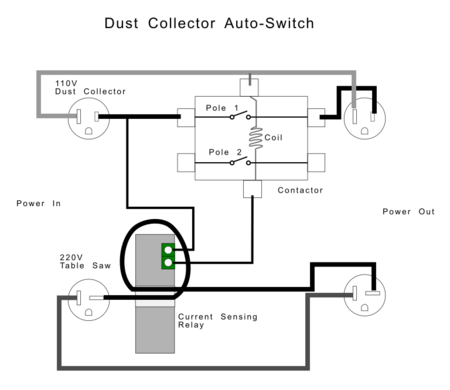Projects:Table Saw Automatic Dust Collection
Table saws are messy, and they need dust collection. The problem is remembering to turn it on. There are various solutions out there on the web to automate your dust collector, but not too many specifically for using a 120V dust collector with a 220V saw. The goal of this project is to create a solution and outline the method so it is easily understood and repeatable.
There are many of components out there for switching and sensing, and there happened to be just the right combination to make a pretty simple setup for this.
Parts
- Dwyer Miniature Current Switch, MCS-111050, Solid Core, .5 to 50 A Continuous - $27.40
- Packard C230B 2 Pole 30 Amp Contactor, 120 Voltage Coil - $10.79
- 16ga Wire, approximately 4 feet - $4
- 220V plug - $7
- 220V outlet - $6
- 120V plug - $4
- 120V outlet - $4
- Enclosure - $15
- Screws
- 2" Conduit clamps for mounting - $8
How it works
The Contactor is essentially a big relay. It takes a small voltage on one pair of terminals, this powers an electromagnet that draws a metal plate down, and that metal plate connects two other sets of terminals carrying much more power. In this case, this Contactor uses 120V at around .04 Amps to trigger the coil, and the main load can carry 120V up to 30 Amps.
The Miniature Current Switch, or Current Sensor as I'll call it, is also a relay but more special. Instead of connecting power to it by a pair of terminals, it receives power through a magnetic field. It is designed to have a wire looped through the center hole. When power runs through the wire, the loop will turn into an electromagnet and turn on the relay. Normally the field around a wire isn't magnetic enough to notice, but this device was made to be very sensitive so it can work with even weak magnetic fields.
Using the Current Sensor, we can sense when there is power traveling through the power cord to the Table Saw. The sensor will close a pair of contacts just like a relay, which we can use to switch something else on. That something else the Contactor, which we will connect our Dust Collector to.
This will be the sequence of events:
- The operator turns on the Table Saw using its power switch.
- The wire inside the Current Sensor creates an electromagnetic field and activates its relay.
- The relay in the Current Sensor connects power to the Contactor, which activates it.
- The power goes through the Contactor and into the Dust Collector.
The power switch on the Dust Collector itself will have to stay in the On position for this to work. The control box we are building will turn it on and off at the same time the operator turns on the Table Saw on and off.
The Wiring
- There are 120V and 220V male and female plugs that are used to make the external connections. Nothing is hard-wired to the box for ease of repair.
- 220V lines are essentially passed through the box. One of the Hot lines must loop through the hole in the Current Sensor in order to create the magnetic field that activates it.
- 120V - Hot side connects to 1 pole of the Contactor, and one of the screw terminals on the Current Sensor.
- 120V - Neutral line goes to the output plug and one side of the coil on the Contactor.
- Ground - all ground connections are connected together.



